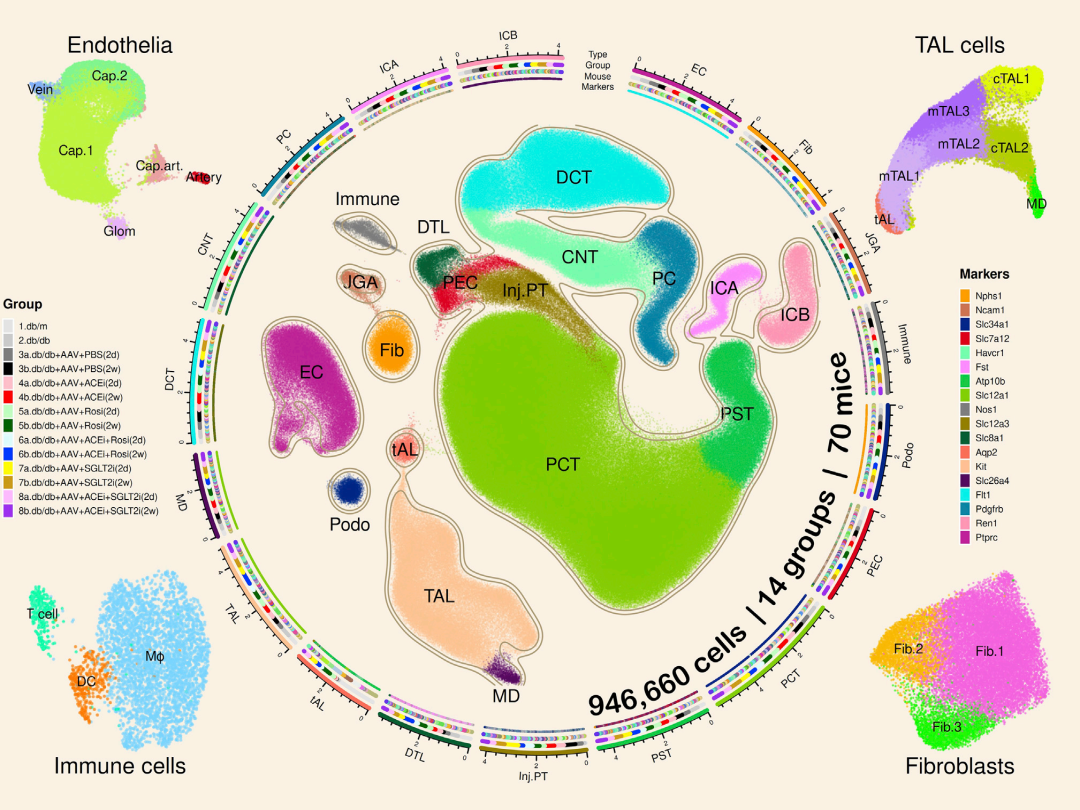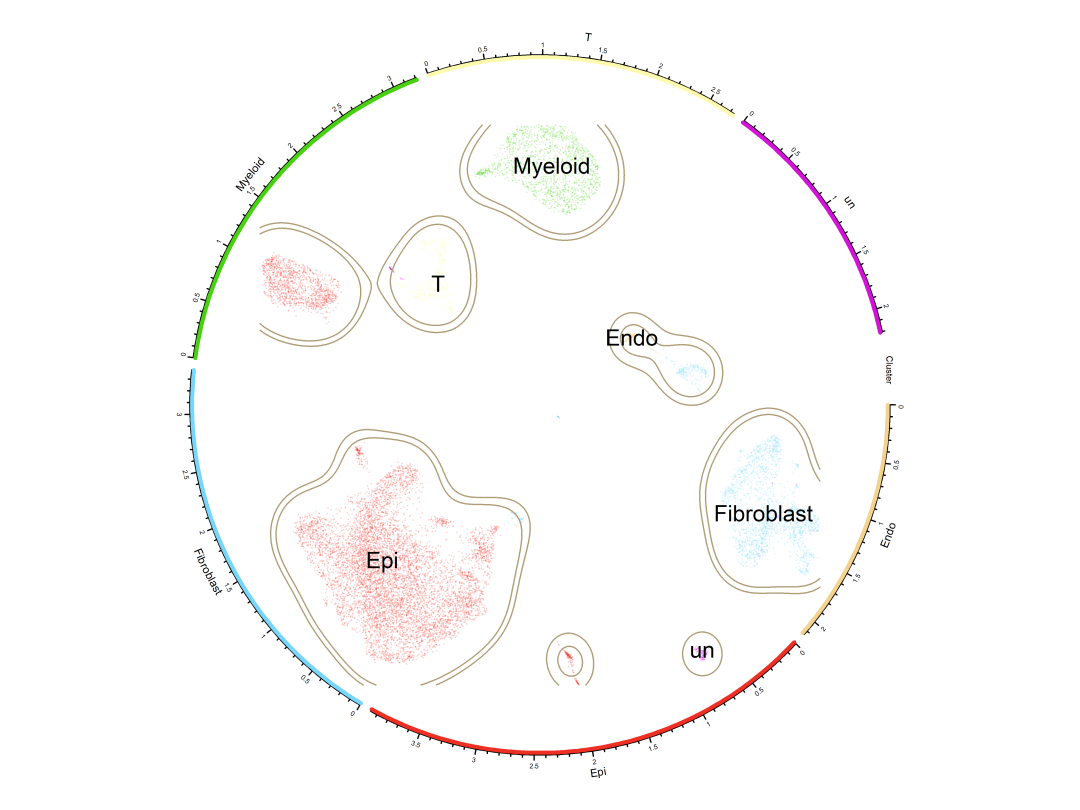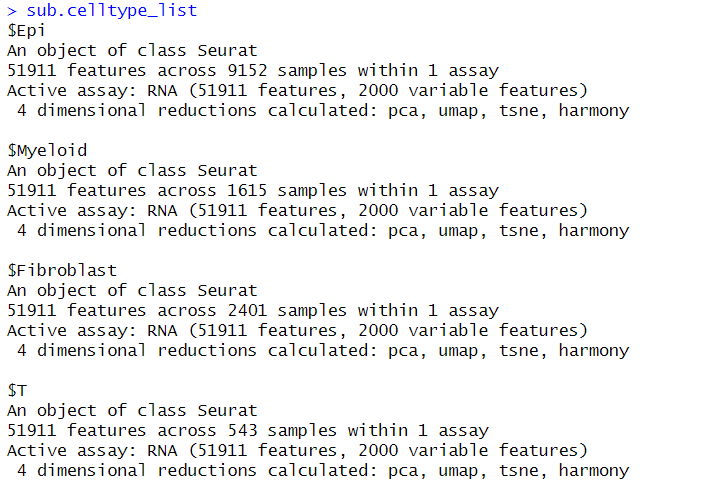scRNA复现|所见即所得,和Cell学umap,plot1cell完成惊艳的细胞注释umap图
scRNA复现|所见即所得,和Cell学umap,plot1cell完成惊艳的细胞注释umap图

生信补给站
发布于 2023-08-25 10:27:24
发布于 2023-08-25 10:27:24
单细胞常见的可视化方式有DimPlot,FeaturePlot ,DotPlot ,VlnPlot 和 DoHeatmap集中 ,在Seurat中均可以实现,但文献中的图大多会精美很多。之前 scRNA分析 | 定制 美化FeaturePlot 图,你需要的都在这介绍了FeaturePlot的美化方式。在跟SCI学umap图| ggplot2 绘制umap图,坐标位置 ,颜色 ,大小还不是你说了算 介绍过DimPlot的一些调整方法,本次再介绍一种更惊艳的umap图。
2022年发表于Cell Metabolism 的Mapping the single-cell transcriptomic response of murine diabetic kidney disease to therapies 文献中有一张主图中绘制的细胞大群及亚群的umap图很惊艳,作者提供了plot1cell 包,本文介绍一下如何复现下图。

一 载入R包,数据
使用之前注释过的sce.anno.RData数据 ,后台回复 anno 即可获取 。这里要下载一下plot1cell图,大概率会提示缺少XXX包,这时候只要指定安装即可。
devtools::install_github("TheHumphreysLab/plot1cell")
#根据实际缺少包进行安装
bioc.packages <- c("biomaRt","GenomeInfoDb","EnsDb.Hsapiens.v86","GEOquery","simplifyEnrichment","ComplexHeatmap")
BiocManager::install(bioc.packages)
dev.packages <- c("chris-mcginnis-ucsf/DoubletFinder","Novartis/hdf5r","mojaveazure/loomR")
devtools::install_github(dev.packages)
#再重新装一次
devtools::install_github("TheHumphreysLab/plot1cell")
library(plot1cell)
library(Seurat)
library(tidyverse)
library(stringr)
library(RColorBrewer)
load("sce.anno.RData")
head(sce2,2)
已经注释过了,下面可以直接使用。
二 plot1cell 函数
1,绘制大群umap图
首先使用prepare_circlize_data函数得到绘图信息,然后plot_circlize函数可以直接绘制umap主图 并把单独的celltype圈画起来 。
###Prepare data for ploting 准备圈图数据
circ_data <- prepare_circlize_data(sce2, scale = 0.8 )
set.seed(1234)
# 设置细胞分群信息的颜色
cluster_colors<-rand_color(length(levels(sce2)))
group_colors<-rand_color(length(names(table(sce2$group))))
rep_colors<-rand_color(length(names(table(sce2$orig.ident))))
# 绘制细胞分群圈图
plot_circlize(circ_data,do.label = T, pt.size = 0.01,
col.use = cluster_colors ,
bg.color = 'white',
kde2d.n = 1000,
repel = T,
label.cex = 0.6)
对比文章图 还缺少(1)背景颜色 ,(2)circos字体较小,(3)外面其他的圈 以及(4)四周的亚群umap图 。
2,背景颜色以及circos大小设置
作者的plot_circlize函数中,将circos图中的刻度和label的大小固定了,需要简单修改一下就可以修改了。修改后的plot_circlize_change 函数可以使用 circos.cex 修改circos刻度的大小 , labels.cex 修改circos上label的大小 。
后台回复 "circos" 即可获得plot_circlize_change 函数文件。
plot_circlize_change(circ_data,do.label = T, pt.size = 0.01,
col.use = cluster_colors ,
bg.color = '#E0D4CA',
kde2d.n = 1000,
repel = T,
labels.cex = 1,
circos.cex = 0.5,
label.cex = 1)3,添加多层track
使用add_track函数添加其他细胞群注释的其他信息 ,可是是metadata中的其他列,这里使用group 和 sample 为例 。
add_track(circ_data,
group = "group",
colors = group_colors, track_num = 2) ## can change it to one of the columns in the meta data of your seurat object
add_track(circ_data,
group = "orig.ident",
colors = rep_colors, track_num = 3)
到这里就完成了主图umap的绘制,其实就可以放到正文了。
三 添加细胞亚型umap
至于最后一点,其实可以用将AI / PS等工具将各个亚型小图的umap PS弄上去,但是这里还是给出使用代码的方式。
1 ,批量亚型分析
因为亚型之前没有分析,这里先批量的进行一下各个亚型的标准Seurat分析(本文不做注释,后续会介绍)
sub_celltype <- c("Epi","Myeloid" ,"Fibroblast" ,"T")
sub.celltype_list <- sapply(sub_celltype,function(slide){
print(slide)
sub.celltype <- subset(sce2 , celltype == slide )
sub.celltype <- NormalizeData(sub.celltype)
sub.celltype <- FindVariableFeatures(sub.celltype)
sub.celltype <- ScaleData(sub.celltype )
sub.celltype <- RunPCA(sub.celltype,npcs = 20)
sub.celltype <- FindNeighbors(sub.celltype,dims = 1:20)
sub.celltype <- FindClusters(sub.celltype, resolution = 1)
sub.celltype <- RunUMAP(sub.celltype,dims = 1:20)
return(sub.celltype)
})
sub.celltype_list
得到的是各个亚型的结果,list形式。
2 ,添加四周亚型umap图
my36colors <-c('#E5D2DD', '#53A85F', '#F1BB72', '#F3B1A0', '#D6E7A3', '#57C3F3', '#476D87',
'#E95C59', '#E59CC4', '#AB3282', '#23452F', '#BD956A', '#8C549C', '#585658',
'#9FA3A8', '#E0D4CA', '#5F3D69', '#C5DEBA', '#58A4C3', '#E4C755', '#F7F398',
'#AA9A59', '#E63863', '#E39A35', '#C1E6F3', '#6778AE', '#91D0BE', '#B53E2B',
'#712820', '#DCC1DD', '#CCE0F5', '#CCC9E6', '#625D9E', '#68A180', '#3A6963',
'#968175'
)
###Fibroblast subtypes
Fibroblast <- sub.celltype_list$Fibroblast
Idents(Fibroblast) <- "seurat_clusters"
subcolors <- my36colors[1:nlevels(Fibroblast)]
#subcolors <- c('#bff542','#83f78f','#EBA1A2','#D70016','#eab3fc','#83b1f7','#D70016','#eab3fc','#83b1f7')
Fibroblast_meta<-get_metadata(Fibroblast, color = subcolors)
Fibroblast_meta %>%
dplyr::group_by(seurat_clusters) %>%
summarize(x = median(x = x),y = median(x = y)) -> centers_Fib
points(Fibroblast_meta$x*0.32-1.2,Fibroblast_meta$y*0.32-0.73, pch = 19, col = alpha(Fibroblast_meta$Colors,0.5), cex = 0.1);
text(centers_Fib$x*0.32-1.2,centers_Fib$y*0.32-0.73, labels=centers_Fib$seurat_clusters, cex = 0.6, col = 'black')注意这里的subcolors 可以自定义,也可以每次都使用my36colors 中的颜色,但是一定要注意以下2点
(1) subcolors 要和 Idents(Fibroblast)中的nlevels一致。
(2)Fibroblast_metax*0.32-1.2和后面Fibroblast_metay*0.32-0.73 中的 0.32 ,1.2 ,0.73等 数值代表位置,可能需要多次尝试。
#T subtypes
T.sub <- sub.celltype_list$T
subcolors <- my36colors[1:nlevels(T.sub)]
T_meta<-get_metadata(T.sub, color = subcolors)
T_meta %>%
dplyr::group_by(Cluster) %>%
summarize(x = median(x = x),y = median(x = y)) -> centers_T
points(T_meta$x*0.32+1.2,T_meta$y*0.32+0.73, pch = 19, col = alpha(T_meta$Colors,0.5), cex = 0.1);
text(centers_T$x*0.32+1.2,centers_T$y*0.32+0.73, labels=centers_T$Cluster, cex = 0.6, col = 'black')
#Myeloid subtypes
Myeloid.sub <- sub.celltype_list$Myeloid
subcolors <- my36colors[1:nlevels(Myeloid.sub)]
Myeloid_meta<-get_metadata(Myeloid.sub, color = subcolors)
Myeloid_meta %>%
dplyr::group_by(Cluster) %>%
summarize(x = median(x = x),y = median(x = y)) -> centers_Mye
points(Myeloid_meta$x*0.32-1.2,Myeloid_meta$y*0.32+0.73, pch = 19, col = alpha(Myeloid_meta$Colors,0.5), cex = 0.1);
text(centers_Mye$x*0.32-1.2,centers_Mye$y*0.32+0.73, labels=centers_Mye$Cluster, cex = 0.6, col = 'black')
##Epi subtype
Epi.sub <- sub.celltype_list$Epi
subcolors <- my36colors[1:nlevels(Epi.sub)]
Epi_meta<-get_metadata(Epi.sub, color = subcolors)
Epi_meta %>%
dplyr::group_by(Cluster) %>%
summarize(x = median(x = x),y = median(x = y)) -> centers_Epi
points(Epi_meta$x*0.3+1.2,Epi_meta$y*0.3-0.73, pch = 19, col = alpha(Epi_meta$Colors,0.5), cex = 0.1);
text(centers_Epi$x*0.3+1.2,centers_Epi$y*0.3-0.73, labels=centers_Epi$Cluster, cex = 0.6, col = 'black')
3 ,添加四周umap的title 和 track的legend
(1)添加,优化四周umap的title ,注意位置和大小
title_text <- function(x0, y0, x1, y1, text, rectArgs = NULL, textArgs = NULL) {
center <- c(mean(c(x0, x1)), mean(c(y0, y1)))
do.call('rect', c(list(xleft = x0, ybottom = y0, xright = x1, ytop = y1), rectArgs))
do.call('text', c(list(x = center[1], y = center[2], labels = text), textArgs))
}
title_text(x0 = -1.35, x1 = -1.05, y0 = -1.06, y1=-1, text = 'Fibroblasts',
rectArgs = list(border='#F9F2E4',lwd=0.5),
textArgs = list(col='black',cex = 1))
title_text(x0 = 1.05, x1 = 1.35, y0 = -1.06, y1=-1, text = 'Epi cells',
rectArgs = list(border='#F9F2E4',lwd=0.5),
textArgs = list(col='black',cex = 1))
title_text(x0 = -1.35, x1 = -1.05, y0 = 1.06, y1=1, text = 'Myeloid',
rectArgs = list(border='#F9F2E4',lwd=0.5),
textArgs = list(col='black',cex = 1))
title_text(x0 = 1.05, x1 = 1.35, y0 = 1.06, y1=1, text = 'T cells',
rectArgs = list(border='#F9F2E4',lwd=0.5),
textArgs = list(col='black',cex = 1))(2)添加track的legend
#plot group#
col_use<-c('#00288A','#DD001F','#84D000','#00CB47','#947F00','#006234')
cc<-get_metadata(sce2, color = col_use)
cc %>%
dplyr::group_by(celltype) %>%
summarize(x = median(x = x),y = median(x = y)) -> centers
col_group<-c('darkgreen','blue')
lgd_points = Legend(labels = names(table(cc$group)), type = "points",
title_position = "topleft",
title = "Group",
title_gp = gpar(col='black',fontsize = 7, fontface='bold'),
legend_gp = gpar(col = col_group),
labels_gp = gpar(col='black',fontsize = 5),
grid_height = unit(2, "mm"),
grid_width = unit(2, "mm"),
background = col_group)
draw(lgd_points, x = unit(15, "mm"), y = unit(50, "mm"),
just = c("right", "bottom"))
OK ,搞定!
参考资料:
https://github.com/TheHumphreysLab/plot1cell
本文参与 腾讯云自媒体同步曝光计划,分享自微信公众号。
原始发表:2023-06-29,如有侵权请联系 cloudcommunity@tencent.com 删除
评论
登录后参与评论
推荐阅读

